When you collect old cameras, sometimes you want to send them in for repair. Depending on the type of camera you have, the number of options for where you can send the camera varies. If it’s a Leica rangefinder or a Nikon SLR, there are usually quite a number of people still repairing them all over the world. If you are in the United States, Europe, or Japan, there is likely someone that can repair your camera.
For Soviet cameras, Oleg Khalyavin is a name that comes up, Mark Hama is the go to expert on all things Yashica, and if you want to get our Minolta Autocord looked at, there is no one better than Karl Bryan.
When it comes to the Kodak Retina series however, it doesn’t matter where in the world you live, the same name will keep coming up. Chris Sherlock.
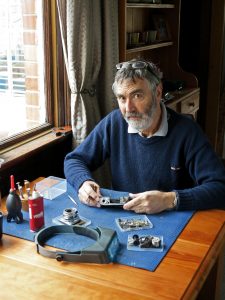
Chris Sherlock is considered by many to be the world’s authority on the entire Kodak Retina system. Although there are a few people who will touch rangefinder or SLR Retinas, I wouldn’t trust mine to anyone who didn’t specialize them as Retinas (especially the Retina Reflex) are notoriously complex cameras that require specialized experience.
Chris’s prices are very reasonable for his services, but shipping is not included in his CLA prices. You’ll have to add on the high cost of postage to and from New Zealand where he is located. For most cameras Chris estimates between $35 – $40 in New Zealand dollars, which as I write this translates to $23 to $26.50 in US dollars. The price to send your camera to him will vary wildly, depending on where you’re at, but it’s safe to say you’re looking at a minimum of $50 USD in shipping there and back.
Earlier this year, I had an opportunity to chat with Chris over Skype (New Zealand is 19 hours ahead of where I live) and I got to know more about who he is, and how he got started.
Mike E – Chris Sherlock is with me today for episode three of One Hour Photo where I have a roughly one hour conversation with some really fascinating people I’ve come across while collecting film cameras. I’ve previously spoken to Chris a number of times in my conquests of repairing some older Retinas, including a failed attempt at a Retina Reflex III which I discussed in a previous article.
Chris, since you’re already pretty well known as “the guy” for Retina Repair, why don’t we get started with how you got started working on Kodak Retinas?
Chris S – Thanks for having me Mike! In 1972 or 73, after I finished high school, I needed a job. I did like many people my age did and picked up the newspaper and looked through the jobs listing for something that looked interesting. There was an ad for a trainee technician at the Kodak Service Center in Wellington, so I went and applied for the position. A couple of days later, I got a call back asking if I was interested in a job and if so, to show up on Monday, so I did.
ME – I can’t imagine they started you right off with Retinas. Did you have to work your way up to them?
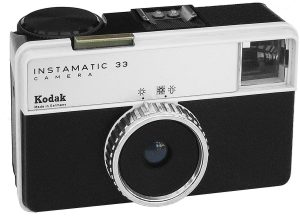
CS – Yeah, when you were new, you started with the simple stuff. In those days, it was mainly Instamatics. The models 25 and 33 were extremely common back then and they came in for repair often, so they were the first cameras I was trained on. They were very simple cameras with few mechanical parts, so repairing them could be done at high speed. When the Pocket Instamatics hit the market, I got my 10 minutes of training and off I went. There were 6 of us in that workshop. We’d get a shopping trolley filled with these cameras that needed to be fixed and we’d pick one out and do it. These Pocket Instamatics were so boring to fix, we’d have time trials to see who could strip them down and back together to counter the boredom. Our best times were between 60 and 90 seconds from start to finish!
ME – laughs I imagine that got boring quick. When did they let you touch “the good stuff”?
CS – After I suppose 6 months, they taught me how to do the 35mm cameras like the Retinas and Retinettes. They never let me near the Reflexes or the Automatics, as those were much more complicated and were reserved for the older, more experienced technicians.
ME – How long did you work there before you got a chance to repair a Retina Reflex or the Automatic?
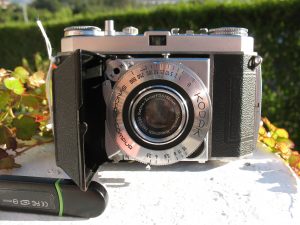
CS – I didn’t. I only worked at Wellington for only 2 years before Kodak decided to pack up the center and move everything to Auckland. I could have kept my job if I was willing to move, which I wasn’t, so I left that job for something else. I didn’t come back to cameras until about 15 years later, after I had my kids and I was looking for a hobby.
At that time, whenever I saw one of the older cameras I used to work on, I’d gather them up and started cleaning and and repairing whatever problems they had. Even though Retinas were well built cameras, they weren’t designed to last forever without being serviced so they always needed something.
ME – Is that when you first tried the more complicated models?
CS – Yeah, as I came across a model I wasn’t familiar with, I’d take it apart and try to figure out how it worked. I had the tools and experience from the other models, so I used what I knew to figure it out on the models that were new to me.
ME – Did you always have a strong mechanical aptitude for tinkering from your father or someone?

CS – Mechanical aptitude skipped a generation in my family. My grandfather was very handy. He was an electrician and could fix a lot of things. I also had a lot of friends at a young age that were apprentice mechanics and it was common to spend weekends helping my friends in a garage getting some old heap up and running again, so I learned a lot about troubleshooting and figuring out how things worked and how to put them back together that way.
I’ve had other jobs working at a local hospital in the orthotics department, making home aides like shower stools, toilet seats, handrails, bum wipers and all manner of weird things. After about 10 years, the government stopped funding the program, so they paid me to go away. I set up a business on my own and kept making the same things and sold them back to the government. I did this for another 9 or so years and then I went into computer repair.
A friend of mine had a computer repair business, and I wanted to learn more about it so he taught me what I needed to know and I went from there.
ME – So, when you started tinkering with Retinas again in the late 80s did you start a side business repairing them for people?
CS – At first, I would repair a camera here and there for collectors I had come across, but quickly realized that I should start charging for my services, so I started spreading my name around local collector groups and my reputation grew. Eventually I setup a simple website and continued to repair Retinas as a side to my main business.
As the years went on, I would still repair computers for people, but eventually demand for computer repair started to disappear. I had some loyal customers but they were getting older and older and I noticed the younger generations no longer wanted to repair anything. Once something broke, they just upgraded to a new model. The demand for my services simply wasn’t there any more.
ME – Has your camera repair business picked up in recent years with the recent uptick in film photography?
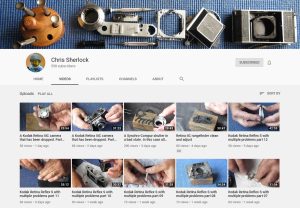
CS – It’s definitely picked up. The one thing that has brought me more recent business than anything else are a series of YouTube videos I’ve been making about camera repair. A lot of the videos show me repairing Retinas, but there’s some for other models too. Currently, I have over 270 videos on my YouTube channel. People watch those videos and ask me questions, but often they end up just sending me their camera to get repaired.
ME – What is a typical workload for you?
CS – Usually, I have a week’s worth of cameras to repair at any given time. That’s about 5 or so cameras. Sometimes it can be double or even triple that, and sometimes it slows down to where I don’t have any. At the moment I have a IIIc in pieces on the table, a Reflex III that’s about to go home, and a Rolleiflex and a Zeiss Contessa waiting to be done.
ME – You mention on your site that you will repair cameras other than Retinas, how do you determine what other cameras you’ll fix?
CS – I require people to contact me in advance to discuss repairs for non-Retina cameras, and I’ll only take models that I feel like working on. There are some that I simply won’t touch either due to complexity or not being familiar with them. There’s others that maybe I’ve fixed before, but I do not have a large supply of spare parts like I do for the Retinas, so if something needs to be replaced, I won’t have the part. It can be difficult to come across parts cameras for valuable cameras like Rolleiflexes, because most people don’t want to part them out. With a Retina, no matter what model, if something is worn out or broken, chances are I have a replacement part somewhere. I can’t say that for other cameras.
ME – What kinds of services do you offer when you repair cameras?
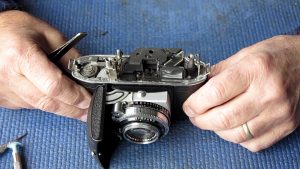
CS – I made a decision long ago only to do complete overhauls. I will not do partial repairs. I don’t want to just repair a shutter, without doing the rest of the camera because it’s only a matter of time before it needs something else. I know that if I take apart a camera and do a complete service and send it back to the owner, I’ll stand behind my work as I’ve done the whole thing and not just part of the job.
ME – There have been a lot of Retinas over the years, have you had a chance to service every single type?
CS – I believe I have. I’ve done the early 117s all the way to the Retina Reflexes and Automatics, but I don’t like working on the Automatics very much.

ME – What is so bad about the Retina Automatics?
CS – They’re very complex and I just don’t like the concept of them. I haven’t done a lot of them, but I’ve taken a few apart, and repaired a couple, but they eat up the time like you wouldn’t believe. People usually aren’t willing to pay the bench time that it takes to realistically repair them. The selenium cells in them degrade over decades and the electrical output is on an S-curve so it’s not as easy as tricking a weak meter by changing the ASA setting or the voltage circuit. Even if you try to adjust them, they’ll only be accurate at one particular light level and it will get more and more worse as the light level changes.
ME – I remember when I was working on my Retina Reflex III, which is now in pieces in my basement, I remember this string that was under the top plate that connected the aperture adjustment wheel on the bottom of the camera to the meter on the top plate.
CS – laughs, Yeah, that’s on the other Reflexes and the IIIS too.
ME – It seems like such a weak point for Kodak to have made such a high quality camera like the Retina and design it with a string holding it together.
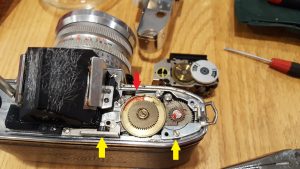
CS – laughs, Surprisingly, that string is a lot stronger than you’d think. It’s made out of silk or some material like that. Although they can break, generally speaking whenever I work on one of those models, the string is fine. What I will see is that sometimes over time, the lube on the drum that the string is wrapped around can become stiff, and cause extra friction that over time can cause the string to rub and possibly fray. Whenever I see a frayed string, I will replace it.
The most common problem is usually the result of some previous repair where someone has taken the front rings off the shutter and put them back in the wrong place, and then kept winding the setting knob on the bottom of the camera causing it to go beyond it’s normal range which tensions up the cord and it breaks. That accounts for an awful lot of the broken cameras, someone else’s repair. Sometimes the camera will still work, but only certain combinations of shutter speeds and f/stops can be selected. In those cases, it likely won’t last very long like that. If the cord isn’t broken and just not aligned, it’s not a hard problem to rectify as the drum at the top of the camera is easy to get to. You just need to know how to do it. But if the cord breaks, it’s a continuous loop that goes from the top to the bottom of the camera, and requires a lot more work.
ME – Overall, it seems the Retina Reflexes get a pretty bad rap for reliability, as do many other leaf shutter SLRs like the Zeiss-Ikon Contaflex, Kowa SLRs, and others. What is it about leaf shutter SLRs that cause them to fail so often?
CS – I think they are well built cameras, but they are exceptionally complex and have a lot of small moving parts that can be easily thrown off by oil and debris if it gets into the mechanics of the shutter. It doesn’t take much to cause them not to work and I suppose that people interpret that as them being unreliable. People need to remember that these cameras were never intended to work for a long length of time without servicing. I remember being told years ago that a Compur type shutter needed to be serviced every 5 or so years to be in proper working condition. You could even push that to 10 years, but beyond that, they all need some kind of help, and if you get a camera that hasn’t been used in 40-50 years, it’s normal for them to need servicing.
ME – Earlier you said that a week’s worth of work is 5 cameras. Does that mean you spend a full day on each camera?
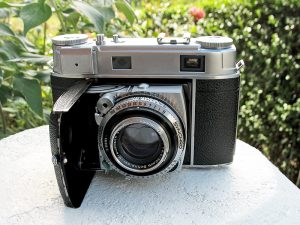
CS – Yes. My bread and butter cameras that I get the most often are the IIIc, IIc, Ia, and IIa which I can usually knock out in about 5 hours from start to finish assuming nothing bad happens.
ME – So, not 60 seconds like the Instamatic 33s?!
CS – laughs, no. More complex cameras like the Reflexes often take a full day, plus about half of a second day before I can get them back together, due to complexity, but there’s never a time where I can get more than one camera done in a single day.
ME – What kind of competition is out there for Retina repair?
CS – I don’t think there is anyone left that specializes specifically in them like I do. There used to be an older guy in Belgium that would buy up a ton of Retinas in Europe and then sell them on eBay, and I had talked to him a couple of times, but haven’t heard from him in quite a while, so I don’t know if he’s still doing it, or even still alive.
Sometimes I’ll get contacted by other camera technicians who are asked to work on a Retina and have specific questions, which I’ll help them out on, but otherwise, I can’t think of anyone else.
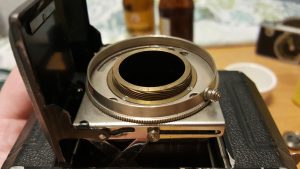
ME – You were a big help to me awhile back when I asked you many different questions about repairing Retinas. I never felt like you thought I was wasting your time as your responses were always helpful and detailed. I haven’t always had that experience though from some other camera technicians. I have written on my site a number of times about simple fixes that can be done to breathe new life into old cameras, and have on occasion received some harsh criticism from those technicians that my methods aren’t correct and that I shouldn’t be telling people the wrong way to do things. What are your thoughts on novices like myself trying simple repairs on cameras, even if it’s not exactly what you would do?
CS – That sort of thing doesn’t bother me at all. I think people have a right to do what they want with their stuff. If they want to take a part a broken camera and try to learn something from it, that’s great. I’m always happy to try and help someone out if they want. That’s why I make the YouTube videos, to help people.
ME – Another point of contention that was brought to my attention by a reader of my site was that I should stop referring to Retinas as having “types” like “Retina Type 117”, but it should be “Nr. 117”. Apparently this is the term “real” Retina collectors use.
CS – laughs, I know who you are talking about, and yeah, it’s a bit pedantic. I suppose that’s a German way of numbering things, but I don’t have any plans on changing my website!
ME – Do you know why those numbers were used at all? What was the point?
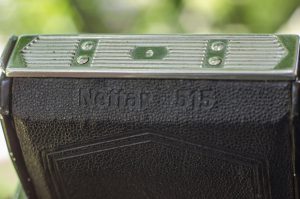
CS – That was one of Nagel’s influences, he did it on other Nagel cameras back then too. It was common at the time for some manufacturers to assign numerical numbers for a catalog or something. Other companies like Zeiss did it too. I don’t think the numbers themselves have any real meaning though.
ME – Let’s say someone was new to film cameras and wanted to get their first Retina. What would be your recommendation on a good first Retina for someone who wanted to shoot one?
CS – I think the Ia, IIa, IIc, and IIIc are all very reliable cameras and great starting points. They’re easy to use, and the design was matured from the earlier models. If someone wants an earlier knob wind camera, the 010 is plentiful and still quite robust and much more reliable than the earlier Retinas. The Ib is an interesting camera, it’s very good too, but bigger.
ME – What was so bad about the early Retinas? Are they not built to the same quality as later models?
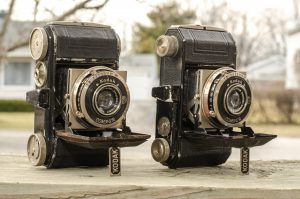
CS – There’s nothing wrong with the earlier Retinas, they are just a bit more delicate. A common problem is the film advance. The whole mechanism just isn’t as robust. I think that’s more of a result that people were more delicate back then too, and weren’t used to tanks like Pentax and Nikon SLRs that could take a beating and keep on going. If someone is rough with an older Retina and forces something beyond it’s limits, they just don’t stand up to abuse as well.
ME – Do you have a preference as your favorite Retina?
CS – I’d have to say the Retina IIc. It’s got great usability and there’s no meter, so less to go wrong. They’re also smaller and easier to put in your pocket.
Fun Fact: In my review for the Kodak Retina Ib, I declared it my favorite Retina because of the speed of which I can zone focus over using a rangefinder, the camera’s excellent ergonomics, looks, and image quality….but the IIc is great too!
ME – On your website, you have a list of cameras in your collection, and you have a wide variety of models, from some really high end to low end models, those made in the Soviet Union, the United States, Germany, Japan, etc. Do you have a theme for which cameras you like to collect?
CS – Not really. Whatever suits my fancy. I have hundreds of cameras and have stopped collecting as I ran out of places to store them. I used to really go after folding 35mm cameras similar to the Retina. I liked the Ikonta 35/Contina, Voigtländer Vito I, II, and III, the Zeiss-Ikon Contessa too. There’s Weltas and Baldas that caught my attention as they were similar to the Retinas as well. I like the Vitessa with the barn doors even though it has a very different design. Beyond that, I like the Contax rangefinders, the Braun Paxette series, and Pentax SLRs.
ME – What was your first camera you ever had?
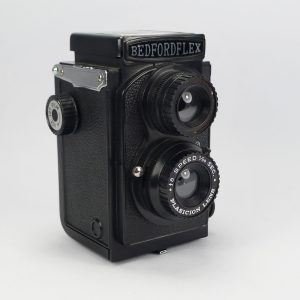
CS – When I was 9 or 10, I got something called the Bedfordflex or Windsorflex. It was a plastic cheap fake TLR. It was an awful camera with light leaks all over the place, but I was a kid. Then I upgraded to an AGFA Clack which was a far better camera. It worked well for me. When I started at Kodak, I bought some Instamatics from the company store to give away as gifts. Sometimes you’d get enough spare parts that you could piece together a working camera from all the broken ones.
My first serious camera was a Pentax Spotmatic F that I bought around 1974 and it cost me the equivalent of about 6 weeks wages. I bought it because I thought it would last me for 25 years. I still have that camera and it still works great, and in the years since, have added many other Pentax SLRs to my collection.
ME – Well Chris, we’ve been talking for about an hour now, so we should wrap this up. Is there anything you think anyone reading this needs to know about you or getting their camera repaired?
CS – Only that they contact me through my website if they have any questions. I am always happy to answer questions.
ME – Thank you Chris for your time. Have a great day!

Closing
If you have any questions for Chris, you can email him at [email protected], or you can visit him at his website, https://www.retinarescue.com, or on his YouTube Channel. Even if you have no interest in seeking out his services for a camera of your own, if you have any level of fascination about Retinas of how cameras are repaired, I still recommend checking out his site and channel just to see how complex these wonderful machines are!
Prior to doing this interview, I had talked to Chris a number of times and without any expectation of payment, he was always cordial and helpful to me. In my time working on this article, I sought out feedback from a number of collectors who had previously sent something to Chris, and I received unanimously high praise about Chris’s work, prices, and turn around time.
If you are interested in some of my Retina reviews, here are some of them.

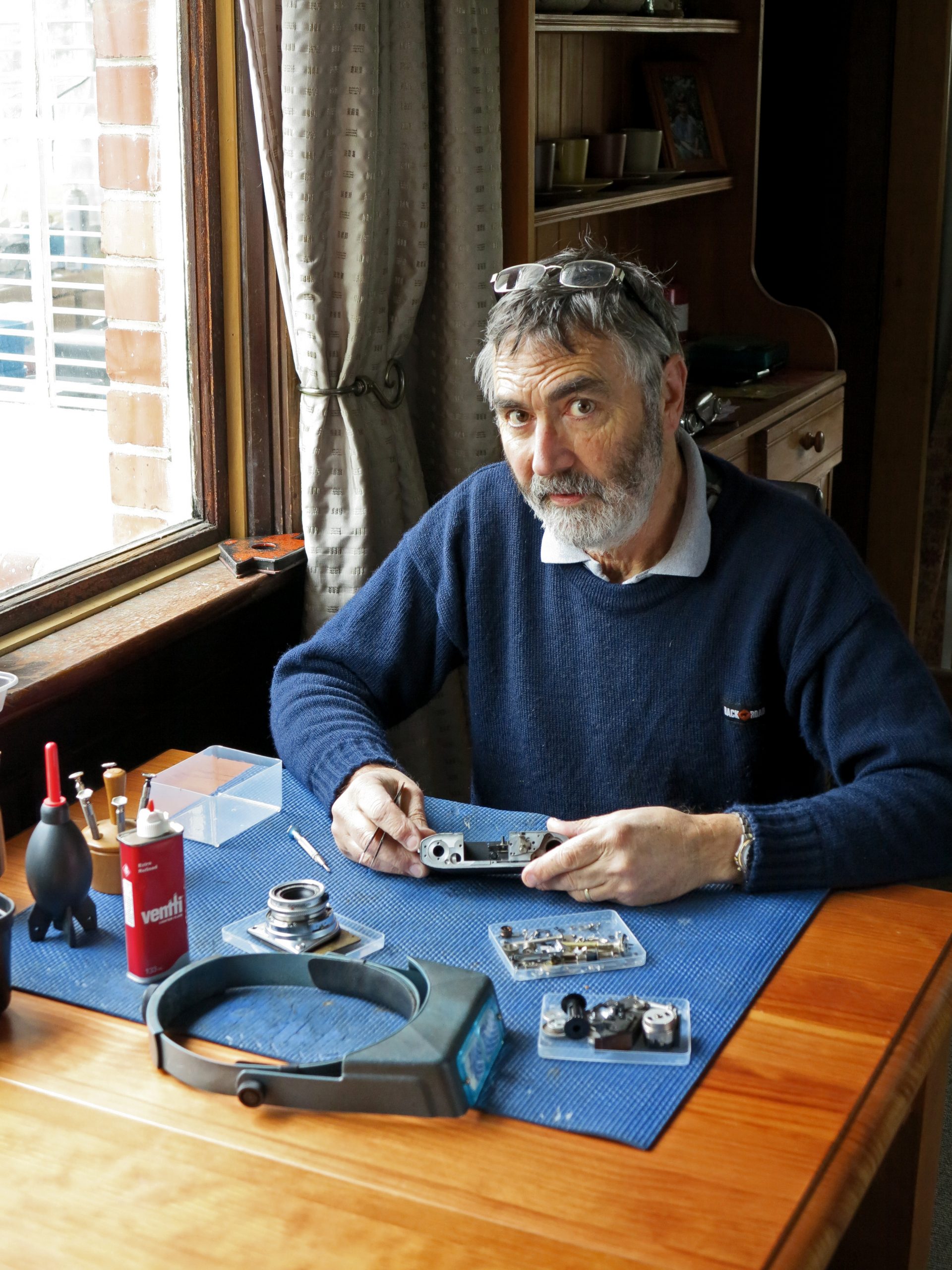


Mike, I enjoyed this article and learning something more about Chris Sherlock. Earlier this year I acquired a near mint Reflex III with the 135 Tele Zenar at a very good price. Initially, all appeared well, the meter was very responsive and the wind on smooth. The shutter speeds were crisp but then I noticed that it wasn’t possible to align the full range of speeds with all the apertures. although with no lens attached all speeds could be set. It didn’t appear that the camera had been “messed with”, but something was clearly out of kilter.
A quick google search found Chris and I had an exchange of emails with him. He was very generous with his time, the outcome of which was he dissuaded me from attempting to play with the shutter and as the camera was still usable over the range of the more useful hand hold-able faster speeds from 1/30 to 1/500 with the Tele-Zenar, it was probably better to leave well alone.
Good to read your interview, it is most interesting, especially since I must have sent a dozen Retina and Retinettes to him for servicing. Nice to get an in depth account of his business. You do good work on your site.
Mike, great interview! For future interviews, I might suggest you mine this vein of experts of particular models, or maybe those who combine service and sales…
Another good post…$50 dollars to send a camera halfway around the world is cheap if your getting “the guy” for repairs. I spent $40 on gas to get my Konica IIIA CLA’D
Great interview, Mike. Chris has refurbished two of my Retina collection, both done to an incredibly high standard. My Type 016 IIa is like a fine piece of jewellery, and produces fantastic results. My nr.118 Retina is also amazing; Chris sorted out the damaged film advance. It’s 84 years old, but takes beautiful photographs.
Thanks for sharing the word about Mr. Sherlock. A few months ago I spottted a IIIC (big C) on That Auction Site that (as usual) was poorly photographed and described … but I could make out the name “Rodenstock” on the lens. I knew this was a Heligon, so I paid a giant $20 plus shipping for it. It proved to be a brick, with a jammed shutter and advance, light fungus in the front element pair, and severe balsam separation in the glass behind the shutter. I shipped it to Chris, and received basically a like-new camera one month later. He cleaned out the fungus, scrounged in his parts bin and replaced the entire set of lens elements behind the shutter, and CLAd the shutter and rangefinder.
.
Chris charged NZ$175 for the basic CLA, NZ$20 for the rear Heligon lens group. I paid NZ$35 for return postage. This converted to US$159. Add to that US$30 for outbound postage, and $29 original postage, and my total investment is US$218. Now look on xBay at the price of a IIIC with an f2 Heligon (if you can even find one), and you’ll see that this is a very fair price. Plus I now have a camera that is silky-smooth to use, fits in my pocket, and produces superb images. Chris now has a IIC (big C) enroute for a CLA. I heartily recommend his services.
In the US, the go-to guy for Asahiflex and Pentax 35mm / medium format SLR cameras is Eric at http://www.pentaxs.com, in Tennessee. Check with him before shipping your camera, as he at times is too covered up to accept another job.
.
Now, does anyone reading this post know of a repair shop that handles Agfa Karats? I have two beautiful Karat 35s, both with f2 Heligons like the Retina Chris Sherlock just serviced for me. Both have typical Agfa jammed focus, plus issues with the shutter release linkages. Recommendations would be most welcome.
Hi Mike,
Thanks a lot for this itw with Chris Sherlock, really interesting !
Some time ago, i found a soggy retina 118 in a bucket, bought it and began to repair it myself… but the door was so corroded that it became welded to the body… had to tear it apart, torned it to pieces…
Well, after some search on the Net, i dared to ask Chris Sherlock if he ever heard of where to find a door for my poor 118…
Guess what ?
Some weeks later, i found a letter from New Zealand, with a door inside… finished my 118 with it, thanked Chris and when shooting !
Well, so yep, i second that, Chris Sherlock is competent, and more over a very nice guy. So, thanks again, Chris !
Here’s the link to my 118’s repaired (feel free to remove it, Mike) :
http://lilianj.com/article43/retina-118
(ah, in french, but with plenty of pics)
Lilian: You should be proud of that repair. You brought that “doorstop” Retina back to life. Most of us would have put a camera in such bad condition into the trash. Felicitations a vous!
Thx Roger !
I found it would be a pity to trash it, so well, did the effort, as 118’s are quite seldom. And i don’t like to trash.
Pics (hopefully online someday) went out ok, just a tiny pinhole somewhere on the bellow.
Et merci pour les félicitations ! 🙂
Great article, Mike. Here is an interesting thing about my experience with Mr. Sherlock. I sent him my 1957 Retina IIIC (“Big C” type 028) in late 2015. After seeing pictures of dismantled cameras on his website (he didn’t have a youtube channel then), I was curious what his job may entail on doing a CLA on my camera. I asked him many questions by email, and in one exchange I asked if he would be so kind as to take a couple pictures of my camera during the process of the CLA and send them to me, so I could see what this process looked like. He said he could. Later, he sent me a link so I could see the pictures. Curious, I clicked on that link, and discovered that he had made an entire new webpage on his site showing every detail of the CLA on my camera. It is still there today: https://retinarescue.com/3cservice.html
That’s a really cool story! Even before doing this interview with Chris, I had talked to him a number of times and was always impressed with his willingness to answer questions and accommodate my questions. He answered several emails as I attempted to fix a Retina Reflex. He’s definitely a class act!